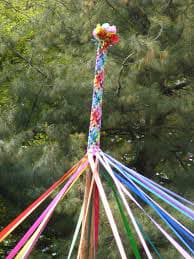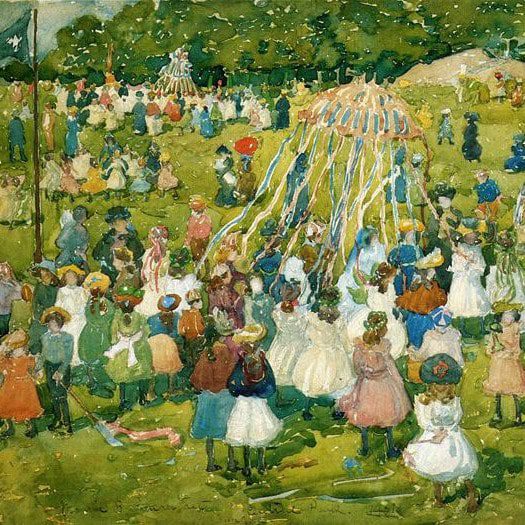May Day—May 1—the first day of the fifth month of our calendar year—conjures the artful image of a circle of celebrants, twirling and dancing around a tall pole, each merrymaker holding one end of a long ribbon tethered to the top of the stanchion.
In the online pages of Encyclopædia Britannica, we are reminded that in medieval and modern Europe May Day was and is a holiday for celebrating the return of spring. “Practices have come to vary widely and include the gathering of wildflowers and green branches, the weaving of floral garlands, the crowning of a May king and queen and the setting up of a decorated May tree, or Maypole.”
 The observance probably originated in ancient agricultural rituals. The Greeks and Romans held spring festivals. “Those rites may have been intended to ensure fertility for crops and, by extension, for livestock and humans, but in most cases this significance was gradually lost, so that the practices survived largely as popular festivities.” Among the many superstitions associated with May Day was the belief that washing the face with dew on the morning of May 1 would beautify the skin!
The observance probably originated in ancient agricultural rituals. The Greeks and Romans held spring festivals. “Those rites may have been intended to ensure fertility for crops and, by extension, for livestock and humans, but in most cases this significance was gradually lost, so that the practices survived largely as popular festivities.” Among the many superstitions associated with May Day was the belief that washing the face with dew on the morning of May 1 would beautify the skin!
Because the Puritans of New England considered the celebrations of May Day to be licentious and pagan, they forbade any observances. Though the holiday never became an important part of American culture, certainly May Day festivities in our country never totally disappeared. I love the May Day story my husband David tells me. When he was a young boy his family would gather spring flowers from their gardens. They filled artfully arranged baskets and quietly left these gifts on the front steps for elderly neighbors to find.
On the web you can find a plethora of beautiful May Day photographs and paintings of American children in school yards, white frocked fair damsels with strapping young men on lawns and gaily dressed adults in many a church close weaving the Maypole dance!
Even so, in the 20th century, traditional May Day celebrations declined in many countries as May 1 became associated with the international May Day holiday, also called Workers’ Day or International Workers’ Day. This day commemorates and honors the historic struggles and gains made by workers and the labor movements worldwide. In the United States and Canada a similar observance, known as Labor Day, occurs on the first Monday of September.
May Day can be more than a spring day for ritual and celebration and an international day to honor workers. The two words, when conflated, have a very different meaning. “Mayday!” is the distress call we often associate with the plight of a sinking ship or a plane going down. Why “Mayday”? Why not S.O.S.? The “mayday” term was first used as an international distress call in the early 1920’s. Before the voice call “mayday”, S.O.S. was the Morse code equivalent call.
“Mayday” was the idea of Frederick Mockford, a senior radio officer at Croydon Airport in London. Mockford came up with his idea for “mayday” when he was asked to think of a word that would indicate distress and would easily be understood by all pilots and ground staff in an emergency. Since much of the traffic at the time was between London’s Croydon Airport and Le Bourget Airport in Paris, he proposed the expression “mayday” from the French m’aider (help me), a shortened form of venez m’aider (come and help me). In 1927, the International Radiotelegraph Convention of Washington adopted the voice call mayday as the radiotelephone distress call in place of the S.O.S. radiotelegraph call. The “mayday” call was made official 1948.
Sometimes I think I can almost hear “mayday! mayday!” going out over Carthage and echoing around the world like a collective shout made in response to the continuing pandemic impact. As individuals and entities call out “mayday! mayday!”—“help us! help us!’—I am heartened to hear encouraging responses. They are coming on many frequencies. Whether on social media or in virtual meetings or via snail or email, the responses are coming!
Yes, in these challenges times, our “mayday!” is heard. Help is on the way for artCentral—our hometown, non-profit arts center! I am eager to share artCentral’s good news stories. Please stay tuned for our spirit-lifting news in the artful month of May!















